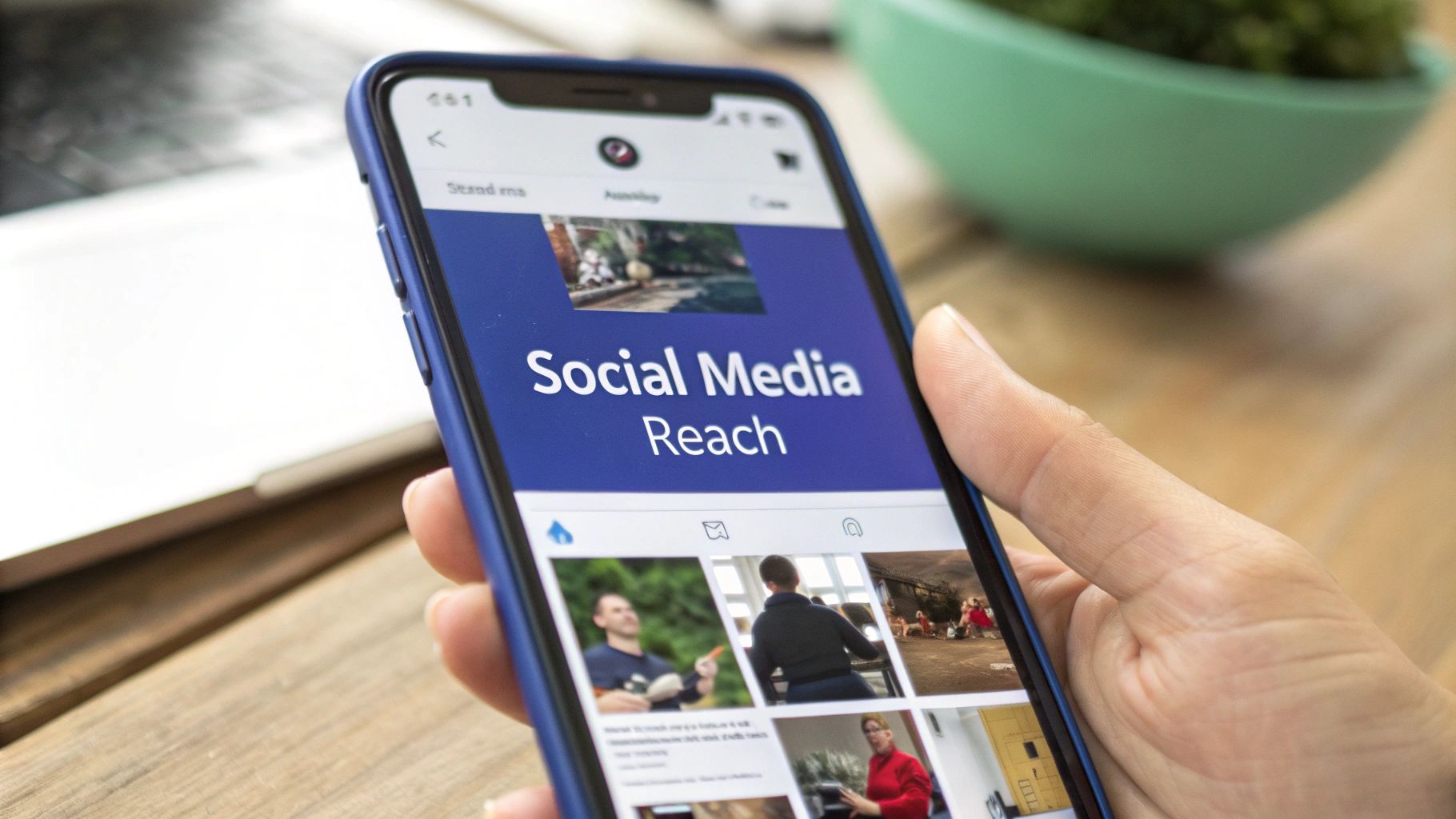Decoding Modern Content Marketing Success

Content marketing isn't just about creating blog posts and social media updates. Smart brands know that success comes from a deliberate approach to investment, distribution, and measuring results. Look at how leading companies are getting exceptional outcomes by letting data guide their decisions and tying content directly to business goals. This strategic mindset is what sets apart content marketing that delivers real impact.
Measuring What Matters: Rethinking Content ROI
While page views and social shares can tell part of the story, they don't show the full picture of content performance. Forward-thinking marketers focus on metrics that connect directly to the bottom line. For example, if lead generation is the goal, they track how many qualified prospects each piece of content brings in. E-commerce brands might zero in on conversion rates and average order values. The key is picking measurements that align with your specific business objectives rather than chasing vanity metrics.
Examples of Successful Content Marketing ROI Strategies
Real companies are showing what's possible with ROI-focused content marketing. Take the software company that created targeted blog posts and webinars addressing a specific customer pain point. By tracking leads and conversions from these resources, they proved clear value from their content investment. Or consider the consumer brand that tapped into user-generated social content – they connected increased reach and engagement to actual website traffic and sales growth. These examples show how aligning content with business goals leads to measurable results.
Building a Framework for Content Measurement
To track content marketing success effectively, you need a solid measurement system. Here's what that includes:
- Clear Objectives: Know exactly what you want your content to achieve – whether that's brand awareness, leads, or sales
- Key Metrics: Choose specific measurements that show progress toward those goals
- Tracking Tools: Put the right analytics platforms and systems in place to monitor your key metrics
- Regular Reporting: Set up consistent check-ins to review performance data and adjust your approach based on what's working
This structured approach beats relying on guesswork. With data guiding your content strategy, you can show concrete business impact and continuously improve your results. The most successful content marketers make measurement a priority from day one.
Smart Investment Strategies That Drive Results
Creating outstanding content requires more than just good writing – it demands smart resource allocation. Success comes from understanding which content investments will make the biggest impact for your specific business and audience. Let's explore proven approaches for getting the most value from your content marketing budget.
Budgeting for Success: High-Budget vs. Lean Strategies
While spending $4,000+ per piece often leads to strong results, don't assume you need a massive budget to succeed. Large companies might invest heavily in polished videos and research reports, while smaller businesses can gain traction through focused blog posts and social media. The key is matching your spending to your goals and capabilities. Both approaches work when aligned with clear business objectives and audience needs.
Maximizing Resources: Hybrid Production Models and Internal Talent
One effective way to stretch your budget is combining in-house and external content creation. For instance, have your team handle core blog posts and ebooks while partnering with specialists for infographics or videos. This lets you tap expert skills while keeping your brand voice consistent. Your internal experts are also valuable content sources – sales teams can share customer insights while product developers can create detailed guides. This adds unique value while controlling costs.
Identifying Profitable Content Types: Aligning with Audience Needs
Smart content investment requires understanding exactly what your audience wants. Look beyond standard formats to analyze how your specific readers prefer to learn. Do they engage more with quick social videos or detailed how-to articles? Are infographics more compelling than case studies? By focusing on formats that resonate most strongly, you'll see better engagement and returns. For deeper audience insights, check out our guide on How to master client feedback.
Measuring the Impact: Focusing on ROI
At its core, content marketing must deliver measurable business results. Set clear goals tied to metrics like website traffic, lead generation, social engagement, or sales. Track these consistently to prove the value of your content investments and identify areas for improvement. Use the data to refine your strategy and focus spending on what works best for your specific situation. This systematic approach ensures your content marketing drives real business growth.
Leveraging AI Without Losing Human Touch

Content marketing is evolving rapidly, with smart marketers finding ways to blend AI capabilities with human creativity. Research shows that about 40% of top-performing content marketers have already begun using AI in their planning process. This shift isn't about replacing human input – it's about using AI strategically to achieve better results while maintaining authenticity.
AI-Powered Content Ideation and Optimization
AI tools excel at analyzing data to uncover content opportunities. By processing search trends, competitor content, and audience behavior patterns, these tools can suggest topics that resonate with target audiences. The numbers speak for themselves – AI-driven content ideation achieves a 47% success rate in creating high-performing content. Many brands have seen efficiency gains of up to 28% by using AI to optimize elements like readability and keyword usage. This frees up content teams to focus on strategy and creativity while automating repetitive tasks.
Practical Applications of AI in Content Marketing Strategy Examples
Here's how a marketing team might use AI during a product launch:
- Identify Key Themes: Study online discussions and competitor content to find the most relevant topics
- Generate Content Briefs: Create detailed outlines covering keywords, formats, and distribution channels
- Optimize Content for Search: Fine-tune content with SEO best practices to improve search visibility
- Personalize Content Delivery: Match content to individual preferences and behaviors
| AI Application | Benefit | Example |
|---|---|---|
| Content Ideation | Identifies trending topics and keyword opportunities | Suggesting blog post titles based on current search trends |
| Content Optimization | Improves readability, keyword usage, and overall content quality | Analyzing existing content and suggesting improvements for SEO |
| Performance Prediction | Forecasts the potential success of content based on historical data | Predicting which content pieces are most likely to generate leads |
Maintaining Authenticity in the Age of AI
The key to success lies in finding the right balance between AI capabilities and human creativity. While AI can generate drafts and analyze data, human writers must shape the final content to ensure it reflects brand values and connects with readers authentically. For example, many successful brands use AI to handle initial content creation but rely on experienced editors to refine tone, style and messaging. This collaborative approach helps companies produce more content while maintaining quality and authenticity. The goal is to let AI handle repetitive tasks while preserving the human elements that make content meaningful and engaging.
Distribution Strategies That Actually Work
Great content is only half the equation – getting it in front of the right audience is equally crucial. With studies showing 60% of people actively seeking useful brand content, you need a solid plan to connect with readers. Here's how successful brands make their content work harder through smart distribution.
Choosing the Right Channels for Your Content
The key is understanding where your specific audience spends their time online. Rather than trying to be everywhere at once, focus your efforts on platforms that match both your content type and target demographic. For instance, if you create visually rich content, Instagram or Pinterest may be your sweet spot. For in-depth technical articles, LinkedIn or email newsletters often work best. A B2B software company might find its developer audience on GitHub, while brands targeting younger consumers may get better results on TikTok.
Adapting Your Content for Different Platforms
Each platform has its own rules of engagement. Simply copying and pasting the same content everywhere rarely works well. Think about customizing your message for each channel – perhaps turning a detailed blog post into bite-sized social media updates, or condensing a webinar into short video clips. It's like serving the same meal in different ways to suit various tastes while keeping the core ingredients intact.
Building a Loyal Following Through Consistent Engagement
Successful distribution is a two-way conversation. By actively participating in discussions, responding to comments, and becoming part of relevant online communities, you create meaningful connections that expand your reach naturally. This ongoing dialogue builds trust and turns casual readers into brand advocates. For example, a company like BugSmash connects with product teams by sharing practical tips and tutorials while staying responsive to user questions and feedback.
Measuring and Optimizing Your Distribution Efforts
Smart distribution requires regular measurement and adjustment. By tracking metrics like site traffic, social engagement, and lead generation, you can identify which channels deliver the best results for your content. Use this data to focus your energy on what works and experiment with new approaches. Success comes from continually refining your strategy based on real performance data rather than assumptions.
Content Refresh Strategies For Maximum Impact

Creating compelling content is just the beginning – the real magic happens when you strategically refresh and optimize your existing content over time. Research shows that updated content can boost engagement by 53%, making content refreshes an essential part of any successful content marketing approach. Let's explore why refreshing content matters and how to do it effectively to drive better results.
Why Refresh Your Content?
Think of content refreshing as giving your best performing pieces a tune-up to keep them running smoothly. Regular updates help you get more value from your existing content while signaling to search engines that your site provides current, relevant information. Fresh content tends to rank better in search results, bringing more organic traffic to your site. You can also incorporate emerging keywords and topics that your audience is actively searching for.
Identifying Content Refresh Opportunities
Success starts with picking the right content to update. Begin by auditing your content and analyzing key metrics. You might be interested in: How to master content engagement metrics. Focus on:
- Traffic: Look for pages showing declining organic traffic trends that could benefit from updates
- Engagement: Check metrics like time on page and bounce rates to spot underperforming content
- Conversions: Identify pieces that aren't effectively moving readers to take action
- Keyword Rankings: Monitor ranking changes to catch content that's slipping in search results
Content Marketing Strategy Examples: Refreshing for Success
Here are proven ways to breathe new life into your existing content:
- Update Statistics and Data: Replace outdated numbers with current research to maintain credibility
- Add New Information: Expand topics with fresh insights, examples and perspectives
- Improve Readability: Break up text blocks, add clear headings, and include helpful visuals
- Optimize Keywords: Research and naturally incorporate relevant search terms
- Refresh Visuals: Replace old images and videos with current, engaging visuals
Prioritizing Content Updates
Be strategic about which content to refresh first. Focus on pieces that have historically performed well or target valuable keywords. This helps you maximize impact while using resources efficiently. Some updates may only need minor tweaks, while others require more substantial revisions. Create a systematic plan to keep your content fresh and relevant for your audience.
Turning Strategy Into Action: Your Implementation Plan

You've seen inspiring examples of successful content marketing in action. But having great ideas is just the start – the real challenge lies in putting them into practice effectively. Let's explore how to create a practical action plan that will help your content marketing deliver consistent results.
Building Your Content Marketing Roadmap
Creating great content is only half the battle. To achieve lasting success, you need a structured plan that guides implementation from start to finish. Here's how to build that roadmap:
- Define Clear Responsibilities: Success requires knowing exactly who owns each part of your content strategy. Designate team members to handle content creation, distribution, promotion, and analytics. When everyone understands their role, work flows smoothly.
- Establish a Content Calendar: A well-organized calendar helps you maintain steady publishing and coordinate your team's efforts. Map out content plans using simple tools like Google Sheets or dedicated content calendar platforms.
- Set Realistic Deadlines: While ambition drives progress, unrealistic timelines lead to burnout. Break major projects into smaller milestones with achievable deadlines that keep momentum going.
- Allocate Resources Effectively: Know what budget and team bandwidth you'll need at each stage. Consider both direct costs and the time investment required from your team.
Avoiding Common Implementation Pitfalls
Even solid strategies can falter in execution. Being aware of these common challenges helps you tackle them head-on:
- Lack of Internal Buy-In: Content marketing needs support across departments. Get key stakeholders on board early by showing how your strategy ties to business goals and ROI.
- Inconsistent Content Creation: Sporadic publishing undermines audience engagement. Start with a publishing schedule you can reliably maintain, even if modest at first.
- Ignoring Performance Data: Let metrics guide your decisions. Regular analysis shows what resonates with your audience and where to focus improvements.
- Failing to Adapt: Stay responsive to what your data and audience tell you. Be ready to adjust your approach based on real performance and changing market needs.
Content Marketing Strategy Examples: Putting it All Together
Here's how a software company might structure their content plan for a new feature launch:
| Stage | Action | Resources | Timeline |
|---|---|---|---|
| Pre-Launch | Create blog posts and social media updates highlighting the upcoming feature. | Content team, social media manager | 2 weeks before launch |
| Launch | Publish a detailed product demo video and host a live webinar. | Video production team, marketing manager | Launch day |
| Post-Launch | Share customer success stories and create in-depth tutorials. | Content team, customer success team | Ongoing |
The difference between mediocre and outstanding content marketing often comes down to execution. By following a methodical approach and learning from real examples, you can turn your content strategy into a reliable engine for business growth.
Want to make your content development process more efficient? BugSmash offers a central hub for reviewing and improving all your content assets. Try it free today and see how smooth content collaboration can be: https://bugsmash.io/




